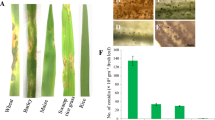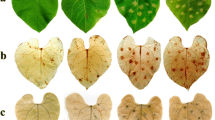Abstract
In this research, 4 rice genotypes and 5 Alternaria alternata isolates were used to study the potential of Alternaria isolates obtained from various rice fields to infect the main rice cultivars planted in Iran and determine the levels of rice resistance to this fungus. Also, we investigated the role of reactive oxygen species (ROS), enzymatic antioxidants and lignin in basal resistance of rice to this necrotrophic fungus. Priming in H2O2 and O2 − accumulation, peroxidase (POX) and superoxide dismutase (SOD) activity and lignification was observed in Shiroodi, as a partially resistant compared to the susceptible Domsiyah cultivar. Application of ROS generating systems increased disease development on both cultivars. In Shiroodi, elevation of O2 − accumulation and SOD activity was observed at 12 h post inoculation (hpi) which was earlier than enhancement of H2O2 accumulation and POX activity at 24 hpi. In addition, application of SOD inhibitor reduced H2O2 and lignin levels and increased disease progress. Similarly, POX inhibitor reduced lignin content of the rice cells which was associated with increased disease index. In overall, both SOD and POX were associated with lignin formation, as a resistance mechanism in rice-A. alternata interaction. However, POX had prevailing function in lignification in our pathosystem.






Similar content being viewed by others
References
Abrahim, N. N., Kanthimathi, M. S., & Abdul-Azizi, A. (2012). Piper betle shows antioxidant activities, inhibits MCF-7 cell proliferation and increases activities of catalase and superoxide dismutase. BMC Complementary and Alternative Medicine, 12, 120.
Alscher, R. G., Erturk, N., & Heath, L. S. (2002). Role of superoxide dismutases (SODs) in controlling oxidative stress in plants. Journal of Experimental Botany, 53(372), 1331–1341.
Alvarez, M. E., Pennell, R. I., Meijer, P. J., Ishikawa, A., Dixon, R. A., & Lamb, C. (1998). Reactive oxygen intermediates mediate a systemic signal network in the establishment of plant immunity. Cell, 92(6), 773–784.
Banerjee, J., & Maiti, M. K. (2010). Functional role of rice germin-like protein1 in regulation of plant height and disease resistance. Biochemical and Biophysical Research Communications, 394(1), 178–183.
Banerjee, J., Das, N., Dey, P., & Maiti, M. K. (2010). Transgenically expressed rice germin-like protein1 in tobacco causes hyper-accumulation of H2O2 and reinforcement of the cell wall components. Biochemical and Biophysical Research Communications, 402(4), 637–643.
Barna, B., Fodor, J., Herrach, B. D., Pogony, M., & Kiraly, Z. (2012). The janus face of reactive oxygen species in resistance and susceptibility of plants to necrotrophic and biotrophic pathogens. Plant Physiology and Biochemistry, 59, 37–43.
Beauchamp, C., & Fridovich, I. (1971). Superoxide dismutase, improved assays and an assay applicable to acrylamide gel. Analytical Biochemistry, 44(1), 276–287.
Bennett, M., Mehta, M., & Grant, M. (2005). Biophoton imaging: a nondestructive method for assaying R gene responses. Molecular Plant-Microbe Interaction, 18(2), 95–102.
Bhuiyan, N. H., Selvaraj, G., Wei, Y., & King, J. (2009). Role of lignification in plant defense. Plant Signaling and Behavior, 4(2), 158–159.
Bradford, M. (1976). A rapid and sensitive method for the quantification of microgram quantities of proteins utilizing the principal of protein-dye binding. Analytical Biochemistry, 72, 248–254.
Broggi, L. E., González, H. H. L., Resnik, S. L., & Pacin, A. (2007). Alternaria alternata prevalence in cereal grains and soybean seeds from Entre Ríos, Argentina. Revista Iberoamericana de Micología, 24(1), 47–51.
Chen, Y. J., Lyngkj, M. F., & Collinge, D. B. (2013). Future Prospects for Genetically Engineering Disease-Resistant Plants. In Molecular Plant Immunity, G Sessa, Ed, Wiley-Blackwell
De Vleesschauwer, D., Chernin, L., & Höfte, M. (2009). Differential effectiveness of Serratia plymuthica IC1270-induced systemic resistance against hemibiotrophic and necrotrophic leaf pathogens in rice. BMC Plant Biology, 9(9), 1–16.
Dong, C. H., Zolman, B. K., Bartel, B., Lee, B., Stevenson, B., Agarwal, B., & Zhu, J. K. (2009). Disruption of Arabidopsis CHY1 reveals an important role of metabolic status in plant cold stress signaling. Molecular Plant, 2(1), 59–72.
Govrin, E. M., & Levine, A. (2000). The hypersensitive response facilitates plant infection by the necrotrophic pathogen Botrytis cinerea. Current Biology, 10(13), 751–757.
Grant, J. J., & Loake, G. J. (2000). Role of reactive oxygen intermediates and cognate redox signaling in disease resistance. Plant Physiology, 124(1), 21–9.
Grant, J. J., Yun, B. W., & Loake, G. J. (2000). Oxidative burst and cognate redox signalling reported by luciferase imaging: identification of a signal network that functions independently of ethylene, SA and Me-JA but is dependent on MAPKK activity. The Plant Journal, 24(5), 569–82.
Hückelhoven, R., & Kogel, K. H. (2003). Reactive oxygen intermediates in plant-microbe interactions: Who is who in powdery mildew resistance. Planta, 216(6), 891–902.
Hückelhoven, R., Fodor, J., Trujillo, M., & Kogel, K. H. (2000). Barley Mla and Rar mutants compromised in the hypersensitive cell death response against Blumeria graminis f.sp. hordei are modified in their ability to accumulate reactive oxygen intermediates at sites of fungal invasion. Planta, 212(1), 16–24.
Jones, J. D., & Dang, J. L. (2006). The plant immune system. Nature, 444, 323–329.
Kar, M., & Mishra, D. (1976). Catalase, peroxidase and polyphenol oxidase activities during rice leaf senescence. Plant Physiology, 57(2), 315–319.
Kesanakurti, D., Kolattukudy, P. E., & Kirti, P. B. (2012). Fruit-specific overexpression of wound-induced tap1 under E8 promoter in tomato confers resistance to fungal pathogens at ripening stage. Physiologia Plantarum, 146(2), 136–148.
Kuta, D. D., & Gaivaronskaya, L. M. (2004). Ca2+ and reactive oxygen species are involved in the defense responses of rice callus culture to rice blast disease. African Journal of Biotechnology, 3(1), 76–81.
Li, F. Q., Toyazaki, N., & Yoshizawa, T. (2001). Production of alternaria mycotoxins by Alternaria alternata isolated from weather-damaged wheat. Journal of Food Protection, 64(4), 567–71.
Liu, X., Williams, C. E., Nemacheck, J. A., Wang, H., Subramanyam, S., Zheng, C., & Chen, M. S. (2010). Reactive Oxygen Species Are Involved in Plant Defense against a Gall Midge. Plant Physiology, 152(2), 985–999.
Manosalva, P. M., Davidson, R. M., Liu, B., Zhu, X., Hulbert, S. H., et al. (2009). A germin-like protein gene family functions as a complex quantitative trait locus conferring broad-spectrum disease resistance in rice. Plant Physiology, 149(1), 286–296.
Morita, S., Kaminaka, H., Masumura, T., & Tanaka, K. (1999). Induction of rice cytosolic ascorbate peroxidase mRNA by oxidative stress: The involvement of hydrogen peroxide in oxidative stress signaling. Plant Cell Physiology, 40(4), 417–422.
Mzid, R., Marchive, C., Blancard, D., Deluc, L., Barrieu, F., Corio-Costet, M. F., Drira, N., Hamdi, S., & Lauvergeat, V. (2007). Overexpression of VvWRKY2 in tobacco enhances broad resistance to necrotrophic fungal pathogens. Physiologia Plantarum, 131(3), 434–447.
Nikraftar, F., Taheri, P., Flahati-rastgar, M., & Tarighi, S. (2013). Tomato partial resistance to Rhizoctonia solani involves antioxidative defense mechanisms. Physiological and Molecular Plant Pathology, 81(1), 74–83.
Ono, E., Wong, H. L., Kawasaki, T., Hasegawa, M., Kodama, O., & Shimamoto, K. (2001). Essential role of the small GTPase Rac in disease resistance of rice. Proceedings of the National Academy of Sciences of the United States of America, 98(2), 759–764.
Orozco-Cardenas, M. L., Narvaez-Vasquez, J., & Ryan, C. A. (2001). Hydrogen peroxide acts as a second messenger for the induction of defense genes in tomato plants in response to wounding, systemin, and methyl jasmonate. Plant Cell, 13(1), 179–191.
Sachan, I. P., & Agarwal, V. K. (1995). Seed discoloration of rice: location of inoculum and influence on nutritional value. Indian Phytopathology, 48(1), 14–20.
Schraudner, M., Moeder, W., Wiese, C., van Camp, W., Inze, D., Langebartels, C., & Sandermann, J. H. (1998). Ozone – induced oxidative burst in the ozone biomonitor plant, tobacco Bel W3. The Plant Journal, 16(2), 235–245.
Shamoradi, M., Sharzei, A., & Basirnia, T. (2012). First report of rice head blight caused by Alternariaalternatain Iran. 20 th Iranian plant protection congress.
Sharma, P., Jha, A. B., Dubey, R. S., & Pessarakli, M. (2012). Reactive oxygen species, oxidative damage, and antioxidative defense mechanism in plants under stressful conditions. Journal of Botany, 2012, 1–26.
Suzuki, Suzuki, Y., Yamamoto, N., Hattori, T., Sakamoto, M., & Umezawa, T. (2009). High-throughput determination of thioglycolic acid lignin from rice. Plant Biotechnology, 26(3), 337–340.
Taheri, P., & Tarighi, S. (2010). Riboflavin induces resistance in rice against Rhizoctonia solani via jasmonate-mediated priming of phenylpropanoid pathway. Journal of Plant Physiology, 167(3), 201–208.
Taheri, P., & Tarighi, S. (2011). A survey on basal resistance and riboflavin-induced defense responnses of sugar beet against Rizoctonia solani. Journal of Plant Physiology, 168(10), 1114–1122.
Thordal-Christensen, H., Zhang, Z., Wei, Y., & Collinge, D. B. (1997). Subcellular localization of H2O2 in plant. H2O2 accumulation in papillae and hypersensitive response during the barley- powdery mildew interaction. The Plant Journal, 11(6), 1187–1194.
Torres, M. A., Jones, J. D. G., & Dang, J. L. (2006). Reactive oxygen species signaling in response to pathogens. Plant Physiology, 141(2), 373–378.
Wally, O., & Punja, Z. K. (2010). Enhanced disease resistance in transgenic carrot (Daucus carota L.) plants over-expressing a rice cationic peroxidase. Planta, 232(5), 1229–1239.
Wang, X., Basnayake, B. M. V. S., Zhang, H., Li, G., Li, W., Virk, N., Mengiste, T., & Song, F. (2009). The Arabidopsis ATAF1, a NAC Transcription Factor, Is a Negative Regulator of Defense Responses Against Necrotrophic Fungal and Bacterial Pathogens. Molecular Plant-Microbe Interaction, 22(10), 1227–1238.
Yu, Q., & Rengel, Z. (1999). Micronutrient deficiency influences plant growth and activities of superoxide dismutases in narrow-leafed lupines. Annals of Botany, 83(2), 175–182.
Acknowledgments
We thank Ferdowsi University of Mashhad for financial support of this research with project number 3/24096 approved on 10/10/2012.
Author information
Authors and Affiliations
Corresponding author
Rights and permissions
About this article
Cite this article
Taheri, P., Irannejad, A., Goldani, M. et al. Oxidative burst and enzymatic antioxidant systems in rice plants during interaction with Alternaria alternata . Eur J Plant Pathol 140, 829–839 (2014). https://doi.org/10.1007/s10658-014-0512-8
Accepted:
Published:
Issue Date:
DOI: https://doi.org/10.1007/s10658-014-0512-8




